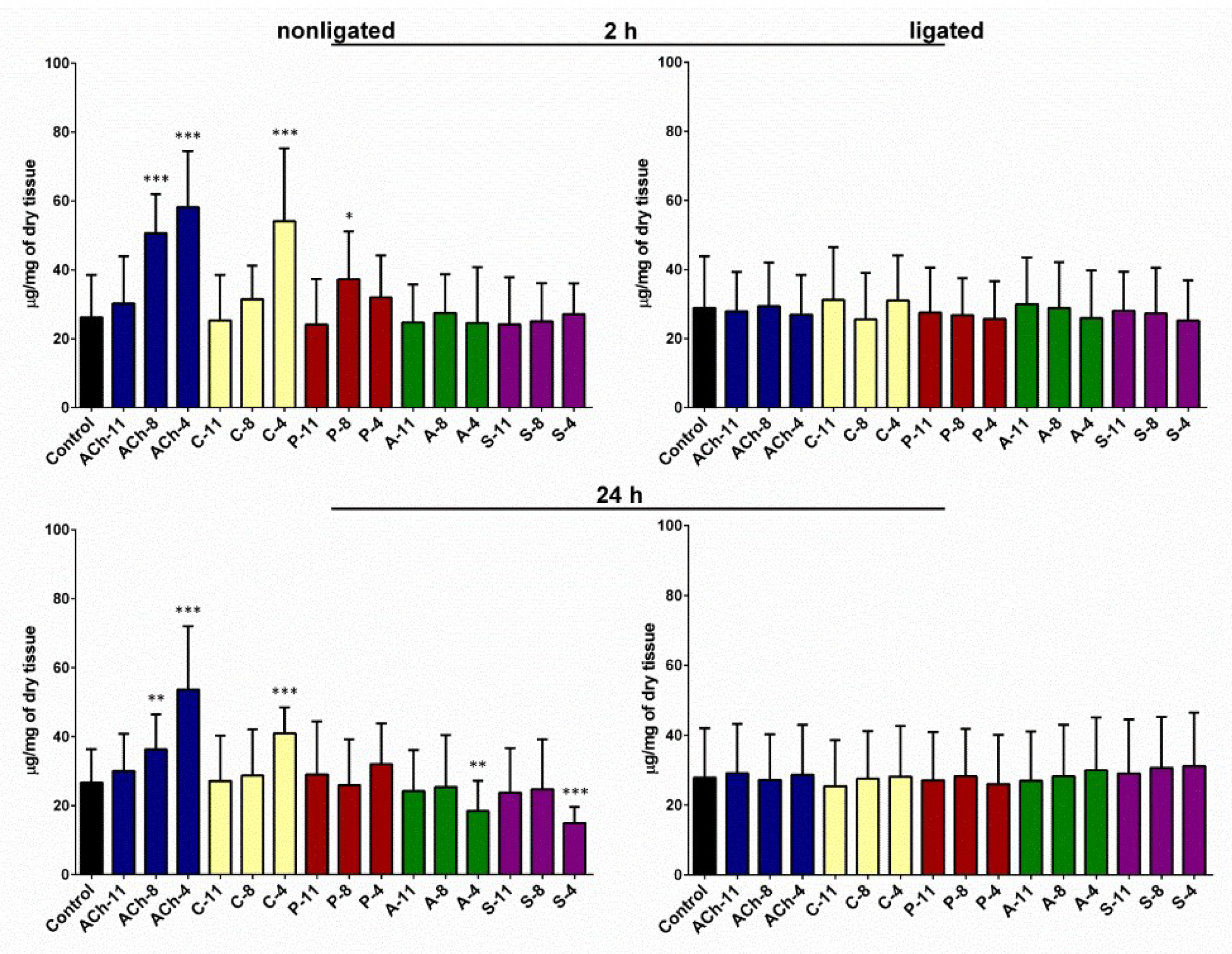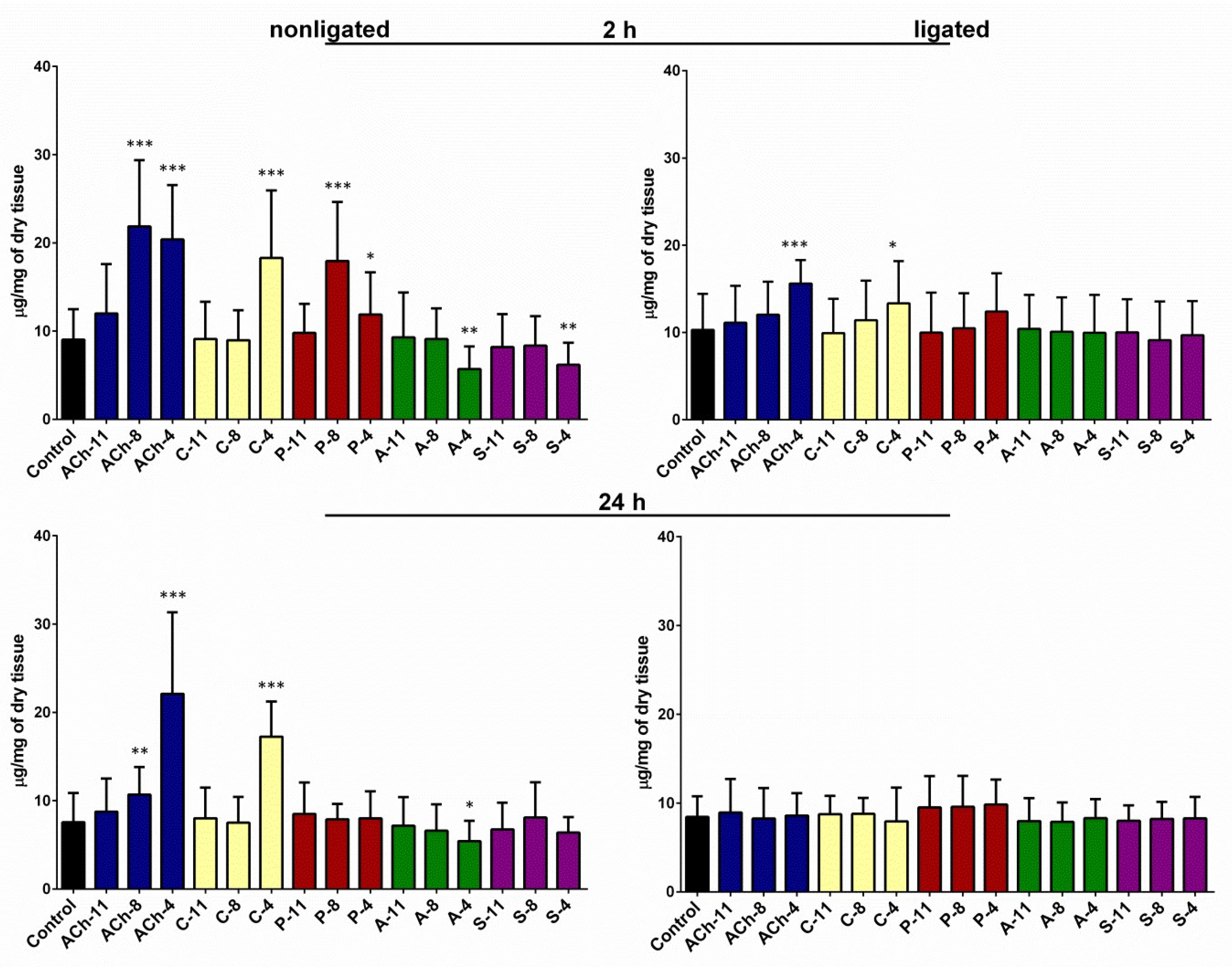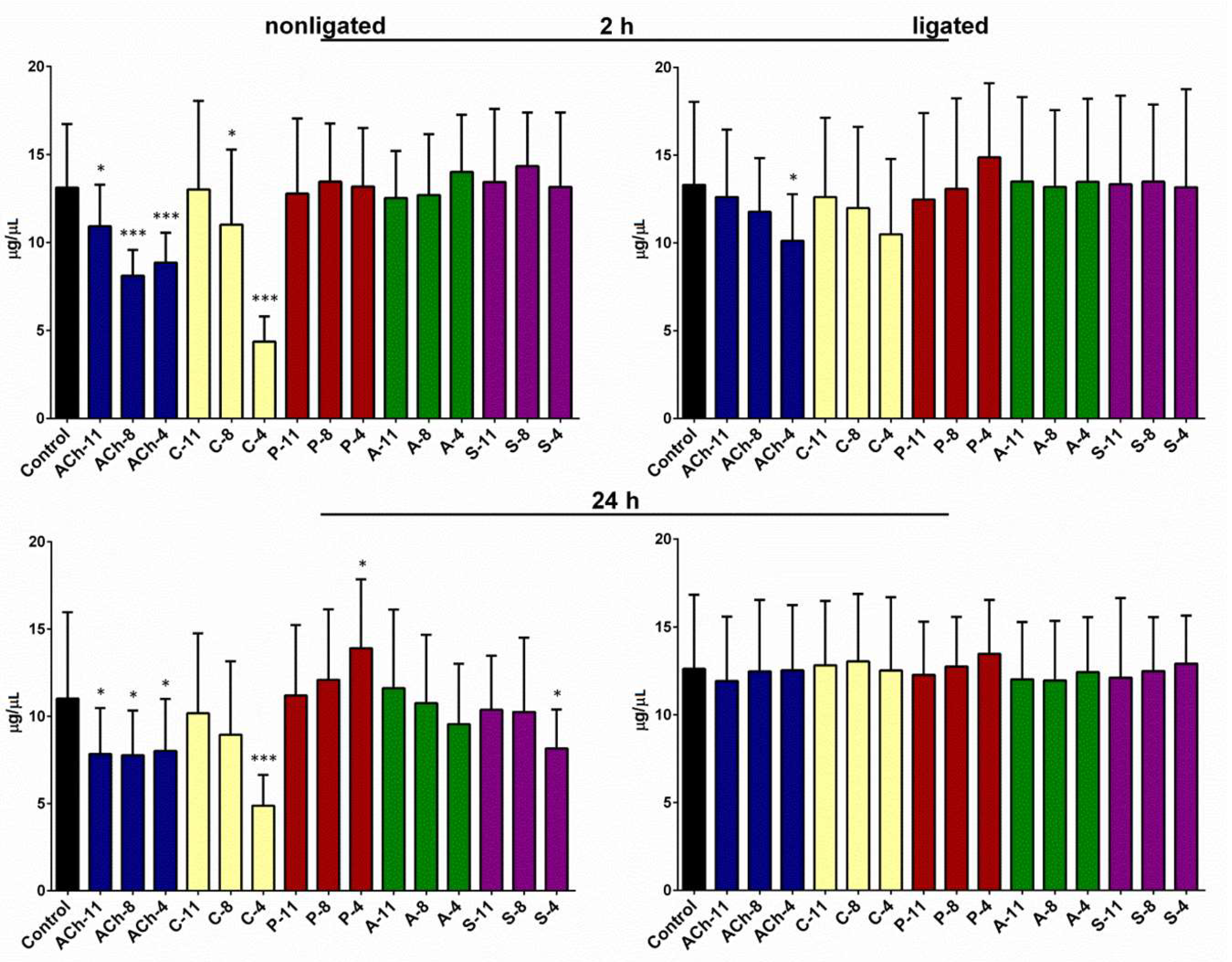Cholinergic Agonists and Antagonists Have an Effect on the Metabolism of the Beetle Tenebrio Molitor
Abstract
1. Introduction
2. Results
2.1. Changes in Glycogen Content in the Fat Body
2.2. Changes in Glycogen Content in the Midgut
2.3. Changes in the Total Free Sugars Concentration in the Hemolymph
2.4. Changes in the Lipids Contents in the Fat Body
2.5. Level of Insulin-Like Peptides in the Hemolymph
3. Discussion
4. Materials and Methods
4.1. Insects
4.2. Tested Compounds
4.3. Determination of Glycogen Content in Tissues
4.4. Measurement of Free Sugars Level in Hemolymph
4.5. Evaluation of the Total Lipids Content in the Fat Body
4.6. Immunoenzymatic Determination of the Insulin-Like Peptides Level in Hemolymph
4.7. Statistics
5. Conclusions
Author Contributions
Funding
Conflicts of Interest
References
- Wessler, I.; Kirkpatrick, C.J. Non-neuronal acetylcholine involved in reproduction in mammals and honeybees. J. Neurochem. 2017, 142, 144–150. [Google Scholar] [CrossRef] [PubMed]
- Eglen, R.M. Muscarinic receptor subtype pharmacology and physiology. Prog. Med. Chem. 2005, 43, 105–136. [Google Scholar] [CrossRef] [PubMed]
- Fryer, A.D.; Christopoulos, A.; Nathanson, N.M. Muscarinic Receptors, 208th ed.; Springer: Heidelberg, Germany, 2012; pp. 48–96. ISBN 9783642232749. [Google Scholar]
- Collin, C.; Hauser, F.; Gonzalez de Valdivia, E.; Li, S.; Reisenberger, J.; Carlsen, E.M.; Khan, Z.; Hansen, N.O.; Puhm, F.; Sondergaard, L.; et al. Two types of muscarinic acetylcholine receptors in Drosophila and other arthropods. Cell Mol. Life Sci. 2013, 70, 3231–3242. [Google Scholar] [CrossRef] [PubMed]
- Ren, G.R.; Folke, J.; Hauser, F.; Li, S.; Grimmelikhuijzen, C.J. The A- and B-type muscarinic acetylcholine receptors from Drosophila melanogaster couple to different second messenger pathways. Biochem. Biophys. Res. Commun. 2015, 462, 358–364. [Google Scholar] [CrossRef] [PubMed]
- Xia, R.Y.; Li, M.Q.; Wu, Y.S.; Qi, Y.X.; Ye, G.Y.; Huang, J. A new family of insect muscarinic acetylcholine receptors. Insect Mol. Biol. 2016, 25, 362–369. [Google Scholar] [CrossRef] [PubMed]
- Gross, A.D.; Bloomquist, J.R. Pharmacology of central octopaminergic and muscarinic pathways in Drosophila melanogaster larvae: Assessing the target potential of GPCRs. Pestic. Biochem. Physiol. 2018, 151, 53–58. [Google Scholar] [CrossRef]
- Hirashima, A.; Oyama, K.; Eto, M. Effects of a muscarinic agonist on octopamine-stimulated cyclic-AMP production in American cockroach (Periplaneta americana) nerve cords. Agric. Biol. Chem. 1991, 55, 2547–2552. [Google Scholar]
- Buhl, E.; Schildberger, K.; Stevenson, P.A. A muscarinic cholinergic mechanism underlies activation of the central pattern generator for locust flight. J. Exp. Biol. 2008, 211, 2346–2357. [Google Scholar] [CrossRef]
- Krause, A.F.; Winkler, A.; Durr, V. Central drive and proprioceptive control of antennal movements in the walking stick insect. J. Physiol. Paris 2012, 107, 116–129. [Google Scholar] [CrossRef]
- Cano Lozano, V.; Gauthier, M. Effects of the muscarinic antagonists atropine and pirenzepine on olfactory conditioning in the honeybee. Pharmacol. Biochem. Behav. 1998, 59, 903–907. [Google Scholar] [CrossRef]
- Ismail, N.; Christine, S.; Robinson, G.E.; Fahrbach, S.E. Pilocarpine improves recognition of nestmates in young honey bees. Neurosci. Lett. 2008, 439, 178–181. [Google Scholar] [CrossRef] [PubMed]
- Malloy, C.A.; Ritter, K.; Robinson, J.; English, C.; Cooper, R.L. Pharmacological identification of cholinergic receptor subtypes on Drosophila melanogaster larval heart. J. Comp. Physiol. B 2015, 186, 45–57. [Google Scholar] [CrossRef] [PubMed]
- Gautam, D.; Jeon, J.; Li, J.H.; Han, S.J.; Hamdan, F.F.; Cui, Y.; Lu, H.; Deng, C.; Gavrilova, O.; Wess, J. Metabolic roles of the M3 muscarinic acetylcholine receptor studied with M3 receptor mutant mice: A. review. J. Recept. Signal. Transduct. Res. 2008, 28, 93–108. [Google Scholar] [CrossRef] [PubMed]
- Tobin, G.; Giglio, D.; Lundgren, O. Muscarinic receptor subtypes in the alimentary tract. J. Physiol. Pharmacol. 2009, 60, 3–21. [Google Scholar] [PubMed]
- Li, J.H.; Gautam, D.; Han, S.J.; Guettier, J.M.; Cui, Y.; Lu, H.; Deng, C.; O’Hare, J.; Jou, W.; Gavrilova, O.; et al. Hepatic muscarinic acetylcholine receptors are not critically involved in maintaining glucose homeostasis in mice. Diabetes 2009, 58, 2776–2787. [Google Scholar] [CrossRef] [PubMed]
- Vatamaniuk, M.Z.; Horyn, O.V.; Vatamaniuk, O.K.; Doliba, N.M. Acetylcholine affects rat liver metabolism via type 3 muscarinic receptors in hepatocytes. Life Sci. 2003, 72, 1871–1882. [Google Scholar] [CrossRef]
- Aizono, Y.; Endo, Y.; Sattelle, D.B.; Shirai, Y. Prothoracicotropic hormone-producing neurosecretory cells in the silkworm, Bombyx mori, express a muscarinic acetylcholine receptor. Brain Res. 1997, 763, 131–136. [Google Scholar] [CrossRef]
- Shirai, Y.; Jiang, Y.L.; Yoshioka, S.; Aizono, Y. The release of an insect neuropeptide hormone, bombyxin, is regulated by muscarinic transmission in the brain-corpus cardiacum-corpus allatum complex of the silkworm, Bombyx mori (Lepidoptera: Bombycidae). Appl. Entomol. Zool. 2001, 36, 431–438. [Google Scholar] [CrossRef]
- Nässel, D.R.; Liu, Y.; Luo, J. Insulin/IGF signaling and its regulation in Drosophila. Gen. Comp. Endocrinol. 2015, 221, 255–266. [Google Scholar] [CrossRef]
- Mizoguchi, A.; Okamoto, N. Insulin-like and IGF-like peptides in the silkmoth Bombyx mori: Discovery, structure, secretion, and function. Front Physiol. 2013, 2, 1–11. [Google Scholar] [CrossRef]
- Nässel, D.R.; Vanden Broeck, J. Insulin/IGF signaling in Drosophila and other insects: Factors that regulate production, release and post-release action of the insulin-like peptides. Cell Mol. Life Sci. 2016, 73, 271–290. [Google Scholar] [CrossRef] [PubMed]
- Sheng, Z.; Xu, J.; Bai, H.; Zhu, F.; Palli, S.R. Juvenile hormone regulates vitellogenin gene expression through insulin-like peptide signaling pathway in the red flour beetle, Tribolium castaneum. J. Biol. Chem. 2011, 286, 41924–41936. [Google Scholar] [CrossRef] [PubMed]
- Sajid, W.; Kulahin, N.; Schluckebier, G.; Ribel, U.; Henderson, H.R.; Tatar, M.; Hansen, B.F.; Svendsen, A.M.; Kiselyov, V.V.; Norgaard, P.; et al. Structural and biological properties of the Drosophila insulin-like peptide 5 show evolutionary conservation. J. Biol. Chem. 2011, 286, 661–673. [Google Scholar] [CrossRef] [PubMed]
- Sevala, V.M.; Sevala, V.L.; Loughton, B.G. Insulin-like molecules in the beetle Tenebrio molitor. Cell Tissue Res. 1993, 273, 71–77. [Google Scholar] [CrossRef] [PubMed]
- Teller, J.K.; Rosiński, G.; Pilc, L.; Kasprzyk, A.; Lesicki, A. The presence of insulin-like hormone in heads and midguts of Tenebrio molitor L. (Coleoptera) larvae. Comp. Biochem. Physiol. Part A: Physiol. 1983, 74, 463–465. [Google Scholar] [CrossRef]
- Słocińska, M.; Czubak, T.; Marciniak, P.; Jarmuszkiewicz, W.; Rosiński, G. The activity of the nonsulfated sulfakinin Zopat-SK-1 in the neck-ligated larvae of the beetle Zophobas atratus. Peptides 2015, 69, 127–132. [Google Scholar] [CrossRef] [PubMed]
- Nation, J.L. Insect Physiology and Biochemistry, 2nd ed.; CRC Press LLC: Boca Raton, FL, USA, 2002. [Google Scholar]
- Chapman, R.F.; Simpson, S.J.; Douglas, A.E. The insects: Structure and Function, 5th ed.; Cambridge University Press: New York, NY, USA, 2013; ISBN 9780521113892 (pbk.). [Google Scholar]
- Gautam, D.; Jeon, J.; Starost, M.F.; Han, S.J.; Hamdan, F.F.; Cui, Y.; Parlow, A.F.; Gavrilova, O.; Szalayova, I.; Mezey, E.; et al. Neuronal M3 muscarinic acetylcholine receptors are essential for somatotroph proliferation and normal somatic growth. Proc. Natl. Acad. Sci. USA 2009, 106, 6398–6403. [Google Scholar] [CrossRef]
- Gautam, D.; Gavrilova, O.; Jeon, J.; Pack, S.; Jou, W.; Cui, Y.; Li, J.H.; Wess, J. Beneficial metabolic effects of M3 muscarinic acetylcholine receptor deficiency. Cell Metab. 2006, 4, 363–375. [Google Scholar] [CrossRef]
- Kopeć, S. Studies on the necessity of the brain for the inception of insect metamorphosis. Biol. Bull. 1922, 42, 323–342. [Google Scholar] [CrossRef]
- Gade, G.; Auerswald, L. Mode of action of neuropeptides from the adipokinetic hormone family. Gen. Comp. Endocrinol. 2003, 132, 10–20. [Google Scholar] [CrossRef]
- Satake, S.; Masumura, M.; Ishizaki, H.; Nagata, K.; Kataoka, H.; Suzuki, A.; Mizoguchi, A. Bombyxin, an insulin-related peptide of insects, reduces the major storage carbohydrates in the silkworm Bombyx mori. Comp. Biochem. Physiol. B Biochem. Mol. Biol. 1997, 118, 349–357. [Google Scholar] [CrossRef]
- Keshan, B.; Thounaojam, B.; Kh, S.D. Insulin and 20-hydroxyecdysone action in Bombyx mori: Glycogen content and expression pattern of insulin and ecdysone receptors in fat body. Gen. Comp. Endocrinol. 2017, 241, 108–117. [Google Scholar] [CrossRef] [PubMed]
- Brown, M.R.; Clark, K.D.; Gulia, M.; Zhao, Z.; Garczynski, S.F.; Crim, J.W.; Suderman, R.J.; Strand, M.R. An insulin-like peptide regulates egg maturation and metabolism in the mosquito Aedes aegypti. Proc. Natl. Acad. Sci. USA 2008, 105, 5716–5721. [Google Scholar] [CrossRef]
- Rosiński, G.; Wrzeszcz, A.; Obuchowicz, L. Differences in trehalase activity in the intestine of fed and starved larvae of Tenebrio molitor L. Insect Biochem 1979, 9, 485–488. [Google Scholar] [CrossRef]
- Van Handel, E. Estimation of glycogen in small amounts of tissue. Anal. Biochem. 1965, 11, 256–265. [Google Scholar] [CrossRef]
- Chowański, S.; Lubawy, J.; Spochacz, M.; Paluch, E.; Smykalla, G.; Rosiński, G.; Słocińska, M. Cold induced changes in lipid, protein and carbohydrate levels in the tropical insect Gromphadorhina coquereliana. Comp. Biochem. Physiol. A Mol. Integr. Physiol. 2015, 183, 57–63. [Google Scholar] [CrossRef] [PubMed]
- Dubois, M.; Gilles, K.A.; Hamilton, J.K.; Rebers, P.A.; Smith, F. Colorimetric method for determination of sugars and related substances. Anal. Chem. 1956, 28, 350–356. [Google Scholar] [CrossRef]
- Folch, J.; Lees, M.; Stanley, G.H.S. A simple method for the isolation and purification of total lipides from animal tissues. J. Biol. Chem. 1957, 226, 497–509. [Google Scholar]
- Chowański, S.; Lubawy, J.; Paluch-Lubawa, E.; Spochacz, M.; Rosiński, G.; Słocińska, M. The physiological role of fat body and muscle tissues in response to cold stress in the tropical cockroach Gromphadorhina coquereliana. PLoS ONE 2017, 12, e0173100. [Google Scholar] [CrossRef]
Sample Availability: Samples of the compounds: carbachol, pilocarpine, atropine, and scopolamine are available from the authors. |





© 2018 by the authors. Licensee MDPI, Basel, Switzerland. This article is an open access article distributed under the terms and conditions of the Creative Commons Attribution (CC BY) license (http://creativecommons.org/licenses/by/4.0/).
Share and Cite
Chowański, S.; Pacholska-Bogalska, J.; Rosiński, G. Cholinergic Agonists and Antagonists Have an Effect on the Metabolism of the Beetle Tenebrio Molitor. Molecules 2019, 24, 17. https://doi.org/10.3390/molecules24010017
Chowański S, Pacholska-Bogalska J, Rosiński G. Cholinergic Agonists and Antagonists Have an Effect on the Metabolism of the Beetle Tenebrio Molitor. Molecules. 2019; 24(1):17. https://doi.org/10.3390/molecules24010017
Chicago/Turabian StyleChowański, Szymon, Joanna Pacholska-Bogalska, and Grzegorz Rosiński. 2019. "Cholinergic Agonists and Antagonists Have an Effect on the Metabolism of the Beetle Tenebrio Molitor" Molecules 24, no. 1: 17. https://doi.org/10.3390/molecules24010017
APA StyleChowański, S., Pacholska-Bogalska, J., & Rosiński, G. (2019). Cholinergic Agonists and Antagonists Have an Effect on the Metabolism of the Beetle Tenebrio Molitor. Molecules, 24(1), 17. https://doi.org/10.3390/molecules24010017






